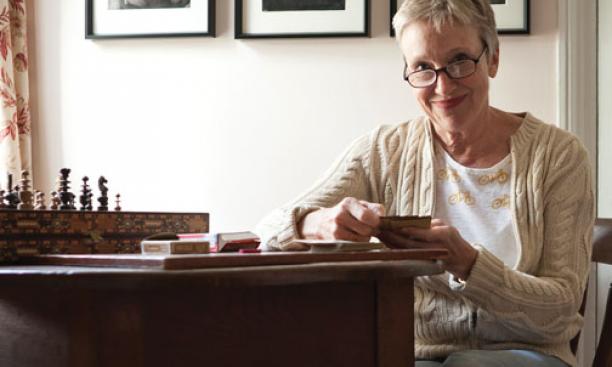


When she was a young girl, Sherry Lefevre ’74 spent three summers with her family in an early 19th-century house on Nantucket — a “funky” place with slanted floors, dark Victorian furniture, a “secret” garden hidden by overgrowth, and lots of old, used things.
The rented house, called Rosemary, “bore a similarity to your sense of entering a different world when you’re on summer vacation,” says Lefevre.
Rosemary and other houses like it on Nantucket — where homes generally were sold furnished and had a casual feel — had a hold on her. “However old the house was, that’s kind of how old the furniture was,” she explains.
Two years ago, when she bought her own house on Nantucket — built in 1819, about the same year as Rosemary — she wanted it to reflect the era that she remembered as a child. An assistant professor of writing at the University of the Arts in Philadelphia, she aimed to create a house that felt like it had been in the same family for generations, “resonates longevity,” and was filled with items that held memories — even if they weren’t her own. Instead of filling her house with her own family’s heirlooms and antiques, she collected other people’s, which she found trolling eBay.
Online, she could buy the kind of items she was searching for — Victorian shell art, seascapes, nautical whale-oil lamps, and place mats with ships on them — for much less money than she could if she purchased similar items at antique shops. She bought nearly all her furnishings and furniture on eBay.
“The things that appeal to me are [things] that are imperfect,” says Lefevre. “They always seem to be on the margins of beauty rather than in the center of beauty.”
One of her favorite finds is a box decorated with shells and pictures, shown above. On either side of the front are photos of girls, and a cracked glass covers one of them. This Victorian shell art, she says, probably was made by a family and calls to mind the shell boxes her own children (including Callie Lefevre ’09) made with her on Nantucket.
Some of the items came with stories. The woman who sold Lefevre a mixing bowl told Lefevre that her grandmother made terrific pancake batter in it.
Lefevre doesn’t mind if the story is true or not — she suspects that some people might invent stories to make the objects more appealing. “I saw my eBay sellers as being kind of my cousins who were giving me all the old inherited stuff that they didn’t want,” she says.
Once she set about her adventure of accumulating other people’s things, she knew she would write about it. “One of the things I teach my journalism students [is] that sometimes you create your news story,” says Lefevre. She spent a sabbatical in the fall of 2010 at her Nantucket house beginning a book manuscript and researching the genealogy of the house, the history of summer houses, and a 19th-century developer, Edward Underhill, who built cottages on the island that were “wonderfully eccentric.”
She decided to hold off completing the manuscript until she landed a publisher. By 7:30 a.m. on the June day that The New York Times ran a story about her “instant heirloom house,” she had received emails from agents interested in her book. She’s working with an agent on a proposal.
